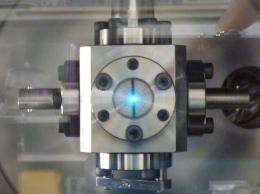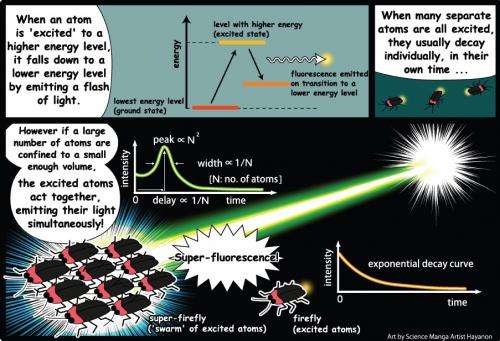November 14, 2011 feature
Researchers take first steps toward X-ray superfluorescence

(PhysOrg.com) -- While physicist Robert Dicke is probably most famous for his work on the cosmic microwave background (CMB) – and being "scooped" while attempting to be the first to detect it – he also performed important work in optics. In 1954, Dicke was the first to describe the phenomenon of "superradiance," the coherent radiation that is so intense and emitted so rapidly that he described it as an "optical bomb." Although he originally thought the phenomenon involved only microwave radiation, it was later found to occur at much shorter wavelengths, and so has been renamed “superfluorescence.” More than 50 years later, scientists are still developing new techniques for producing superfluorescence. In a recent study, a team of scientists based in Japan has observed superfluorescence by collectively exciting helium atoms with a laser operating in the extreme ultraviolet (EUV) region.
The scientists, led by Mitsuru Nagasono from RIKEN/SPring-8 in Sayo, Hyogo, Japan, have published their study in a recent issue of Physical Review Letters.
“Our work represents the first step towards generating X-ray superfluorescence using an X-ray free-electron laser (FEL),” Nagasono told PhysOrg.com. “This is one of the first demonstrations of a quantum optics effect at wavelengths outside (shorter than) the visible wavelength region. Effects in quantum optics have revolutionized science and applications in the visible region, and have potential to do so again as they are extended first to the EUV region and eventually to X-rays.”
Superfluorescence is a quantum phenomenon that occurs after incoming light irradiates an ensemble of atoms. After the atoms become excited, they collectively decay and collectively emit superfluorescent light. (In normal fluorescence, the incoming light also irradiates an ensemble of atoms [or ions or molecules], but their decay results in individual emission, rather than collective emission, of light.) As a result, superfluorescent light is much more intense than fluorescent light, particularly when a large number of atoms decays at once.

In the new study, the researchers demonstrated that an FEL operating in the EUV region can be used to irradiate and excite helium atoms, causing them to collectively decay and emit superfluorescence in the visible region. In their experiments, the researchers pumped helium gas through a pulsed nozzle into a cell within a vacuum chamber. The nozzle’s pulses were synchronized with FEL pulses that entered the cell through one aperture and exited through a second aperture along the same axis that ran through the center of the cell.
Looking through a viewport in the vacuum chamber containing the cell, the researchers could observe visible radiation emitted in the direction of the FEL pulses. Using a fiber-optic spectrometer, the researchers measured the wavelength of the radiation to be 501.6 nm (in the bluish-green part of the visible spectrum). Their measurements also showed the superfluorescence to have a high intensity (up to 1011 photons per pulse) and short pulse duration (on the order of picoseconds).
While the researchers here used FEL pulses in the EUV region to generate superfluorescence in the visible region, they predict that it should be straightforward to extend the technique to generate superfluorescence in the EUV and X-ray regions by choosing appropriate pulse wavelengths and atomic systems. While neutral gas atoms were used as the system in this study, positive ions, nanoparticles, clusters, or solid targets could prove suitable for extension to shorter wavelengths.
As Nagasono explained, superfluorescence at short wavelengths could lead to a route for solving some of the problems of the SASE (self-amplification by spontaneous emission) process used by FELs. The pulses from SASE FELs have profiles that are “spiky” in wavelength and time, vary shot by shot, and are not fully temporally coherent.
“As well as the interest in observing (for the first time) superfluorescence at shorter and shorter wavelengths, superfluorescence is potentially a fully coherent light source in its own right,” Nagasono said. “Laser-like light sources in the X-ray wavelength region are a 'holy grail' of modern science. All current and under-construction FELs rely on the SASE process, offering high spatial coherence, but only partial temporal coherence. In contrast, superfluorescence is fully coherent, and we envision potentially using it to provide fully coherent pulses at particular X-ray wavelengths.”
He added that superfluorescence in the EUV and X-ray regions could have several research applications.
“Potential applications could include determining element-specific atomic densities in, for example, X-ray coherent imaging,” Nagasono said. “Also, since superfluorescence is strongly directional, it may offer a way of increasing sensitivity in X-ray fluorescence spectroscopy analyses. In standard techniques, the X-ray fluorescence is emitted over a large range of angles, and only a small fraction of it can be detected. With superfluorescence, the emission is concentrated into the forward (and possibly backward) directions and can potentially be fully detected – increasing the sensitivity by orders of magnitude.”
More information: Mitsuru Nagasono, et al. “Observation of Free-Electron-Laser-Induced Collective Spontaneous Emission (Superfluorescence).” Physical Review Letters 107, 193603 (2011). DOI:10.1103/PhysRevLett.107.193603
Journal information: Physical Review Letters
Copyright 2011 PhysOrg.com.
All rights reserved. This material may not be published, broadcast, rewritten or redistributed in whole or part without the express written permission of PhysOrg.com.


















